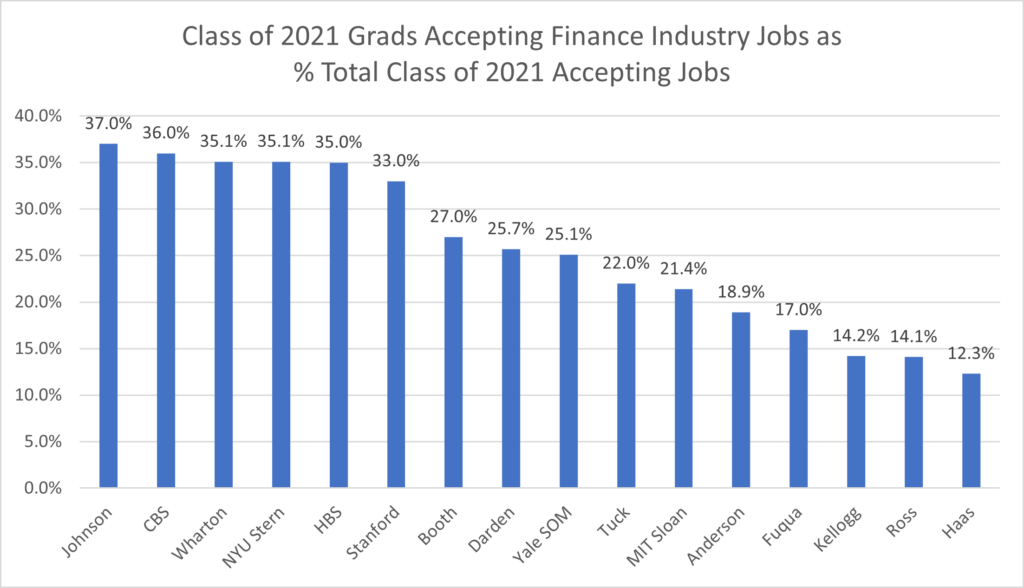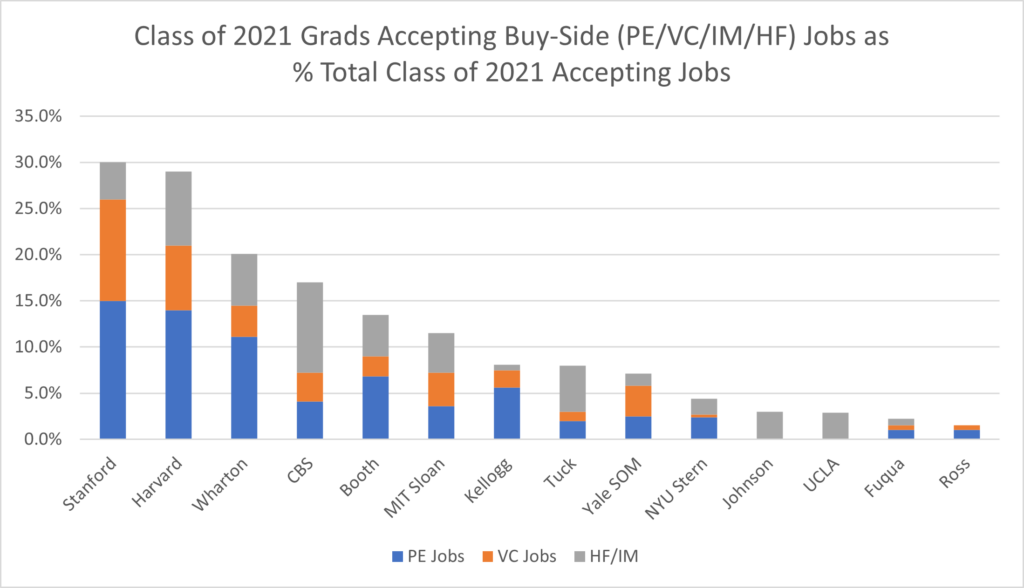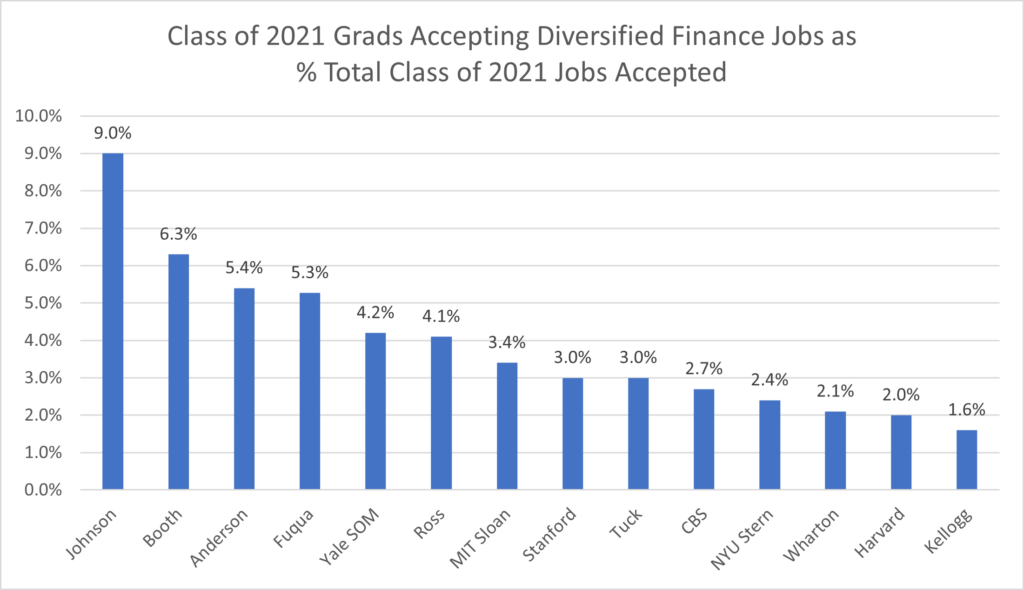For many years, MBA graduates have been drawn to careers in the finance industry due to high compensation and the chance to work on high profile deals at an investment bank or invest in the next billion dollar company at a venture capital or private equity firm. In this installment of Top MBA Program Career Placement Outcomes, we take a closer look at the finance industry placement across leading business schools. Key categories include sell-side investment banking jobs, buy-side jobs in investment management, private equity (PE) & venture capital (VC) as well as other finance industry jobs in commercial banking and insurance.
Background Note on Sell-Side vs. Buy-Side Firms
Sell-side firms sell financial products to institutional investors. Buy-side firms are investment firms with capital to invest in financial products. For example, a sell-side investment bank might help broker the sale of a company to a private equity firm. Sell-side firms such as investment banks typically offer formal training programs to new employees. This makes it easier for MBA students to enter the finance industry by joining an investment bank. In contrast, buy-side firms – whether a private equity firm or an investment management firm – often don’t offer extensive training programs. Instead, they tend to hire MBA job candidates with prior finance experience. Thus, a common MBA career path in finance is to first work in an investment bank before transitioning to a private equity or investment management role.
Class of 2021 MBA Job Placement in the Finance Industry
Here is a chart showing the percent total of Class of 2021 MBA graduates seeking employment who accepted jobs in the finance industry as a percent of the total Class of 2021 graduates seeking employment who accepted jobs. This is data from the Class of 2021 employment reports from 16 full-time U.S.-based MBA programs.

Jobs in the finance industry are quite popular with MBA graduates: 6 full-time MBA programs (Johnson, CBS, Wharton, NYU Stern, HBS and Stanford) send over 30% of graduates seeking employment into finance industry jobs and 3 full-time MBA programs (Booth, Darden and Yale SOM) send over 25%. In contrast, Kellogg (14.2%), Ross (14.1%) and Haas (12.3%) send fewer graduates into finance industry jobs.
Now we will review the schools based on their subcategory of finance industry jobs.
Venture Capital & Private Equity

Stanford GSB (11%) and HBS (7%) send the highest percentage into venture capital jobs. Then there are four MBA programs which each send over 3% into VC jobs: MIT Sloan (3.6%), Wharton (3.4%), Yale SOM (3.3%) and CBS (3.1%). In contrast, Fuqua, Ross and Stern each send fewer than 0.5% into venture capital positions while neither Anderson nor Johnson report any Class of 2021 graduates accepting venture jobs.

Similarly, Stanford (15%) and HBS (14%) send the highest percentage of Class of 2021 grads into private equity jobs, followed by Wharton at 11%. Booth (6.8%) is fourth and Kellogg (5.6%) is fifth. In contrast, Fuqua and Ross send 1% or less into private equity jobs. In addition, neither Anderson nor Johnson report any Class of 2021 graduates accepting private equity jobs.
This table combines both PE and VC jobs accepted by Class of 2021 graduates of these 14 MBA programs:

Of the Stanford GSB Class of 2021 graduates seeking employment who accepted jobs overall, a whopping 26% accepted a job either in venture capital or private equity. HBS is close behind Stanford with 21% going into either PE or VC. Wharton is third with 14.5% and Booth is fourth with 9%. Kellogg, CBS, Sloan and Yale each send over 5% into either PE or VC. In contrast, Fuqua, Ross, Anderson and Johnson send very few graduates into either PE or VC.
Investment Management & Hedge Fund Jobs
Next is a table summarizing the buy-side investment management (IM) and hedge fund (HF) jobs accepted by the Class of 2021 graduates seeking employment as a percentage of the total jobs accepted by the Class of 2021:

Here, CBS sends the highest percentage (9.8%) of graduates into investment management jobs. This is likely influenced by their well-known value investing program. HBS (8%) is second, Wharton (5.6%) is third and Tuck (5%) is fourth. In contrast, Fuqua, Kellogg and Ross each send less than 1% into investment management jobs.
Buy-side Summation
The following table shows the percent total of Class of 2021 MBA graduates going into buy side roles in private equity, venture capital, investment management and hedge funds:

In summary, Stanford (30%) and Harvard (29%) send the highest percentages of Class of 2021 MBA graduates into buy-side investment jobs, followed by Wharton (20.1%), CBS (17%), Booth (13.5%) and Sloan (11.5%).
While Kellogg, Tuck and Yale have a similar overall percentage in buy-side jobs (about 8% each), Kellogg is more weighted to PE jobs, Tuck is more weighted to investment management jobs while Yale is more weighted to VC jobs.
Anderson, Fuqua and Ross have a smaller percentage of graduates going into buy-side jobs.
Investment Banking Jobs
Both Stern (28%) and Johnson (25%) send the highest percentage into sell-side investment banking jobs. In contrast, Harvard (4%) and Stanford (0%) send the lowest percentage into investment banking. You can see this in the table below:

Diversified Finance Jobs
Johnson also sends 9% into diversified finance, which includes sell-side finance industry jobs in commercial banking and insurance positions. Booth (6.3%), Anderson (5.4%) and Fuqua (5.3%) also send over 5% into diversified finance positions:

Finance Industry Jobs by Category
Having compared the job placement by MBA programs by different finance industry categories, we now can show the full composition of finance industry jobs by MBA program:

In summary, while all of these MBA programs have a good track record of placing graduates into good jobs in the finance industry, there are clearly some patterns in buy-side vs. sell-side job placement that may be of interest to prospective MBA applicants seeking a finance industry career post MBA. “Digging into the specifics of finance placement is really illuminating, and there are many key takeaways here. One aspect that stands out is the fact that HBS and Stanford have such a high percentage of buy-side job placement and low percentage of sell-side job placement” Graham Richmond, Co-Founder of Clear Admit noted.









